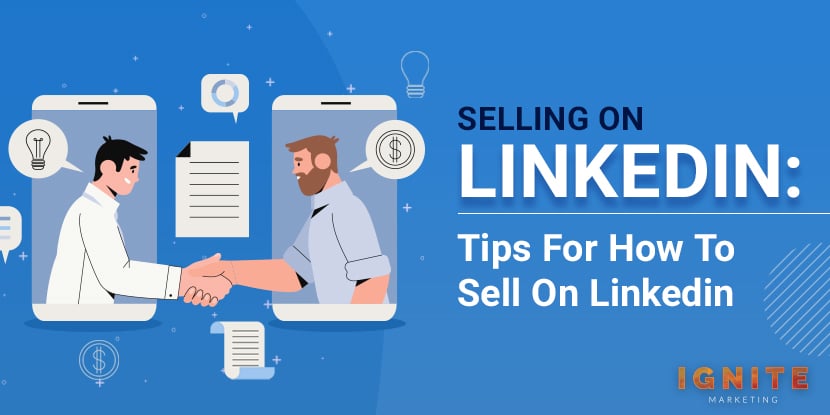


LinkedIn, the professionals' most preferred social media platform, has about 740 million users and growing every day. But despite the vast membership, many budding and established sales professionals and B2B social selling enthusiasts still find it hard to generate leads and boost sales. Why? Many are yet to know the best practices on how to sell on LinkedIn.
So, what are the best tips for selling on LinkedIn? Here we go!
In this post, we look at what LinkedIn social selling is, how to start selling on LinkedIn, and more so, comprehensively detail the proven hacks and secrets of using LinkedIn to sell to help scale your relationships, brand, and influence.
It's probably not the first time you're hearing this 'buzzword.'
Social selling is the act of embracing your social media platform, in this case, LinkedIn, to find new prospects, approach them, create relationships and maintain closeness to make it easy to sell.
With social selling, prospects have you as the first option whenever they need the services you offer. It's because you've already engaged, and they know the value you bring onboard.
Today buyers' know what they want and will choose brands they have bonded with. A simple cold call might not convert. 90% of business decision-makers no longer respond to cold needs.
And that's where social selling comes in; to find, relate, engage and build long-lasting relationships with relevant contacts and decision-makers that assure business.
Do you have a LinkedIn account? If yes, you've already made the first step towards social selling. But how do you prepare for a successful social selling journey? Well, here's are the secrets:
Start with setting a routine plan that you stick to. Whether you're doing it yourself or with a team, have an outline with specific details on finding prospects, ways to nurture them, time to spend each step, and so on.
Marketing plays a significant role when it comes to social selling. Marketing involves promotions and getting your brand to sell. Social selling deepens the prospects' relationships where your products are, easing the sales process.
Allow your brand to stand professionally. Know the prospects to connect with and depict yourself as an industry leader. That brings deeper connections and trust, which means long-lasting relationships and more sales.

Are you looking forward to investing in LinkedIn social selling? You need these tips to reduce prospects' contact time, shorten the sales path, boost your leads and conversion rate, and your favorite—grow your brand exponentially using LinkedIn.
Let's dive straight into the tips!
81% of prospects will prefer doing business with brands that have a solid social media presence. A well-crafted and optimized LinkedIn profile is a stepping stone to establishing a brand that people love to connect and interact with.
But there is one major problem:
Many personal and business profiles are not 100% complete. And do you know what that means? Being invisible, lacking viewership, and not connecting with relevant prospects. With millions of daily active LinkedIn users, ignoring your profile gives competitors a chance to outshine you.
That's not what you want. Here's the good news! It's still not too late to optimize your LinkedIn profile. Do it now!
Here are the critical thoughts and tweaks that should give your profile a new breath that creates a professional impression and stimulates interactions:
A profile photo in your LinkedIn account can boost your viewership by 11 times. But not just any image. A professional profile picture that's up to date, inviting, and business-like with a clear resolution.
A headshot your potential prospects won't doubt or have trouble recognizing in online and offline meetings that you schedule to close deals.
LinkedIn headlines allow you to add the title of your job, present company, and a tagline. The headline is your LinkedIn prime arsenal, and creativity has to come in handy here. Add a value proposition to showcase value.
Since it appears below your profile, it's pretty visible to everyone viewing your profile. Ready to have a headline that sells? Here are LinkedIn headline best practices:
Summaries communicate your story in an optimized manner. Who are you? What do you do? Highlight your brand's profile in an impressive, authentic, and little salesy manner. And importantly, keep it precise, three to four concise sentences. Ensure you restate your compelling headline and include keywords that position you first during searches.
As part of LinkedIn summary content, share what you've achieved. Avoid being too wordy by sharing a link to your websites and portfolios. End with a call to action.
Excellent summaries are conversation starters. It's because you've familiarized your brand to prospects and won their trust.
Presentations and videos showcase prowess and are game-changers when coupled with relevant links. You'll realize this feature among top social sellers on LinkedIn. It converts pretty well and gives your summary a complete optimization.
Other vital things to focus on and maximize the effectiveness of your profile for social selling on LinkedIn include:
90% of businesses with maximum focus on prospects' personas have a clear understanding of what they want.
Here's the thing: who you approach and how you approach them matters a lot in sales and building trustworthy relations.
Being personable goes beyond meeting over a cup of coffee. You'll have to present yourself as a human, with the personality and preferences of your prospect in mind. That way, you link up quickly because you know the prospect's problems to solve and burdens to ease.
It can be challenging, but it all starts with basic research. For instance, a lawyer offering consultancy on divorce issues needs to research who potential prospects are based on their personality, behaviors, age, location, or gender, then connect with them to address the hassles they face in each element.
With fierce LinkedIn competition, developing a buyer persona is not an exception. Most often, businesses go for personable sales to better understand their customers and generate a high ROI.
But that's not the only goal. The buyer persona approach helps laser target your connections and reduce opposition whenever you make a move. For serious Linked social sellers—in businesses of all types, this is the first inbound social selling move to make before connecting around with prospects.
LinkedIn boasts a solid yet comprehensive search capacity. If there's something LinkedIn enthusiasts won't stop applauding, it's the LinkedIn search. Unfortunately, many are yet to exploit its search capability and witness the transformation that comes along.
The search can either be basic or advanced. The basic search gives results, yes, but limits the search to second-degree prospects. You also can't save searches. If you need more, Advanced Search is the real deal.
Access the Advanced Search by clicking next to your search bar.
Type the prospect's name and narrow it to precise details. That means if you're targeting top-level prospects in a specific company, you'll have the list with ease. Being particular helps reach people who find value in connecting and building relationships with you.
Get much more profound in your search by subscribing to the Premium Search plans; LinkedIn Sales Navigator and LinkedIn Recruiter.
LinkedIn Sales Navigator helps find the best-fit prospects. If you want to save your leads, monitor their progress, and reach out, consider a Sales Navigator. It also allows you to integrate the CRM, calls, and emails. LinkedIn Recruiter Advanced Search works best for recruiters.

More than 76% of buyers are ready to converse with potential businesses and partners. But what if you've been connecting with prospects, but your sales efforts aren't bearing fruits? Well, the chances are that you're committing social selling mistakes.
What should you do to find and connect with customers, clients, and partners? The hacks below will change the whole narrative. Brace yourself!
Do you know that you can collect emails from LinkedIn?
You've probably not given it a thought, but it's doable; with the right procedural approach, it should work in your favor.
LinkedIn allows you to generate a spreadsheet with prospects' details, with names, email and position included. Note that you'll only have details for profiles you've added to your network. LinkedIn is highly cautious about personal data, and your spreadsheet will only showcase emails for contacts who have allowed sharing them with the public.
Notwithstanding, here's how you go about it:
You'll agree that, at times, you receive several notifications any time your prospects get new roles. If you don't, click on the notifications tab and allow for the latest job updates. Upon receiving the notification, reach out immediately to get on-time attention.
With a new role, many people have overwhelming excitement, and reaching out fast at that time, increases the chances of successfully starting a conversation that might lead to incredible social relationships.
Give your network a boost from your first-degree connections (people you already have an existing connection with). The prospect links you to second-degree connections. A well-thought second-degree connection might be your potential client.
For instance, if your brand targets chiropractic patients, reach out to a potential second-degree prospect who connects with your first-degree chiropractic prospect. Let's say a second-degree connection working in a local spa or senior home. Since such places attract people with a need for chiropractic services, building a relationship with someone who works there will boost your business through recommendations.
But don't connect blindly. Know when to approach and craft some warm invitations hard to turn down using InMail. Alternatively, talk to your first-degree connection to introduce you.
But that's not all! Here are some creative ways to add people close to your network:
Your Newsfeed has a lot to offer. It depends on how you use it. If you're not definite on the updates that show up, you will have a lot of information that you don't need at the moment. Narrow down to categories that prompt updates that can generate warm connections.
Here's how you do it:
Below where you write or paste your post on your LinkedIn homepage, there's a "sort by" option with an option to click on top, recent posts, or all updates. Click on All Updates and narrow to connections.
Once your connection connects to someone, it will show on your Newsfeed—monitor connections, and when convinced that a particular connection is a potential prospect, connect with them.
Do it right away when the activity is still fresh in their mind. Request for introduction if your connection knows the prospect.
Just like you can filter your News Feed for warm connections, you can also narrow further to recommendations. That means you'll get notified anytime your connections get recommended. The good thing about recommendations is that they come from solid relationships.
If you get a notification that your very close connection, someone you easily talk to, has been recommended by potential prospects, that's an excellent chance to ask for an introduction. If you do it right, engaging those who give or receive recommendations generate transformative relationships.
There's that one magical connection you wish every prospect you meet turns out to be like them. Maybe you've had a cordial relationship that has translated to amazing deals, or they keep on referring clients to you.
So, how do you find similar prospects? It's simple.
Browse your favorite client's profile; upon full access, look at the far right; you can easily spot the "People Also Viewed" sidebar. Seek the most potential profile and do your thing— send a LinkedIn message, InMail, or seek an introduction.
If you're using LinkedIn premium, InMail is the real deal for generating high-profile leads. It's a messaging feature best for reaching out to people outside your network. With a customized message, you can connect with industry experts and decision-makers.
According to LinkedIn, InMail messages enjoy a greater open rate than cold emails.

Social selling is a continuous process if you want relationships that last. Present relationships are sure and effortless ways to move your sales to a whole new level. You can maximize your present connections through the following ways:
There are two main types of prospects here. Those who view your profile often and those you can't miss their comments on your posts.
If someone has been monitoring you, it means there might be something they're interested in. Unlike the free version, Premium LinkedIn makes it possible to know everyone who has viewed you. If the viewer's details rhyme with your brand's orientation, reach out and actualize the relationship.
Do you want to know those commenting on your LinkedIn posts? Click the dropdown menu below your profile and select the Posts & Activity option. From this, you'll know the most active followers who might turn out to be perfect prospects.
It's still possible to close clients that are not in your network. It happens all the time. Whenever you do business, invite them and let your connection grow.
Have a professional approach, and send a customized invitation. And by the way, since you know each other, why not email them first or make a call before sending your customized LinkedIn request. With such a move, it's hard to get no for an answer.
But don't stop there. Stay in touch. It's easy to engage them when you're sourcing for recommendations and referrals. Quick access to their profile will also reveal shared connections that you can target.
It would be wrong to assume that once you've connected with a prospect and offered your services, they'll always get back to you later when they need you. That doesn't happen all the time. Remember, many providers approach the prospect every day with better and affordable deals.
Don't assume you're in their mind when you don't do much to keep them engaged.
Monitor what they do, and subscribe to alerts that notify you what they're up to. For instance, if you notice something about them on the Newsfeed and beyond LinkedIn, take advantage of that information to reach out.
Many publications, from articles, news to press releases, monitor business and will have a lot to talk about them. For instance, send a compelling message of congratulations when you notice your prospect received an award or recognition.
Other ways to know much about your prospects ongoing include:
If a prospect can interact with your posts, why not revert with a relevant comment on some of their posts? Such gestures help maintain closeness. With such familiarity, prospects will not post next time they need help; they'll call or message you directly. Good business, right?

Competition among local businesses is very fierce. If you don't do anything about it, you won't make substantial sales. Connecting with your competitor's prospects allows you to interact and know whether they might have interest in you.
Your local competitor is probably in your network. If not, search them and look at their prospects. Spot the right prospects and shoot your shot. This approach gives immediate results. Since such prospects have an idea about your services, they'll learn your intentions immediately.
If the prospects had a bad experience with the competitor, they will give you a chance because they want the best. But again, give value!
The beauty of LinkedIn groups is you can build mutual connections with prospects way before reaching out. You just need to showcase your expertise, give value and relevance in the engagements you put across.
Presenting your brand in a very salesy approach shouldn't be a priority. The idea is to give helpful contributions that solve your connection's problems. LinkedIn groups are among the most regulated and very private—it's serious business here, and conversions do convert!
Numbers don't lie. According to LinkedIn:
Despite being "gold mines" and powerhouses for meaningful relationships and lead generation, best practices come in handy. Remain authentic, don't bully around, don't spam, and post strategically.
But that doesn't mean you should join any group that pops out and starts commenting. If at all you aim at is LinkedIn social selling, a strategy comes in handy. Do the following:
Aim to become a thought leader in your groups of choice. People will know you based on your value and familiarity and won't hesitate to connect with you.
If that's not enough, create a group and connect with like-minded prospects. It might take time, but it pays off in the long run. Ensure you add the right network, focus on your social selling goals and breathe value to members. Why? Such LinkedIn groups allow for deep connections and increased potential networks.
You cannot separate social selling and quality content. LinkedIn generates 80% of B2B leads.
But why such a high number? The simple answer is, content.
But not just posting and spamming prospects. You need a proper content strategy and excellent ideas on blog posts, insights, and industry news to generate quality leads and sell to the maximum. Be at the top of your prospects mind with the following LinkedIn content approaches:
LinkedIn Pulse (previously LinkedIn Articles) works perfectly when sharing the content of any specifications. Considering that long-form content gets a huge viewership in LinkedIn when you give value to your connection, LinkedIn Pulse is all you need to stimulate engagements. Articles posted on LinkedIn pulse appear on Google's vast network, which means people across the Internet will keep reading them.
Most prospects have questions that need answers from a professional perspective. Giving relevant solutions brings out the expertise prowess in you. Such prospects are easy to build trustworthy relationships with and will always revert when a need arises.
Use your 700 or 1300 characters posts to brief, inspire, educate or inform your prospects on relevant issues that make them better.
The golden rule is to be precise with your posts and aim to grab the reader's attention. LinkedIn users love scrolling their Newsfeed. Your post might only be noticed once. Give it your best. That doesn't mean posts do have massive views. In fact, with the right content, posts get more views and reactions than articles.

How do you know you're making progress selling on LinkedIn?
It requires a detailed strategy and time to track and analyze individual interactions through various metrics. Only 15% of marketers can evidence, with well-quantified data, their social selling approach progresses.
While measuring success is paramount, it won't be of any value if you focus on the wrong metrics. Here are some key parameters you can't ignore:
How to sell on LinkedIn should never be challenging again. Embrace the above straightforward and actionable tips to sell and grow your brand. We don't disagree that having a direct sales approach gives results. But being social and building relationships converts better in LinkedIn and guarantees long-term exponential growth.
Don't be left out. Many businesses' social selling on LinkedIn are now taking the market by storm. Need help selling on LinkedIn? It's not too late to get started. At Ignite marketing, we are just a call away. Let's do this!
